Ridi Viharaya or Ridee Viharya at Rideegama, near Dambulla in Sri Lanka, is one of the most important temples for the followers of Theravada Buddhism in this part of the world. It is situated in the serene neighbourhood of Rideegama in the Kurunegala district. In this complete guide to Ridi Viharaya Silver Temple, we will see how the fortunes of the ancient city of Anuradhapura and King Dutugemunu were intertwined with Ridee Viharaya temple, so much so that the Ruwanwelisaya temple might not have been so grand if not for Ridee silver temple.
Ridi Viharaya (Ridee Viharaya), the Silver Temple
The beautiful majestic Ridi Viharaya is a sight to behold for all visitors. Built in the 2nd century BCE, on a hill full of caves, overlooking the lush green charming landscape of Kurunegala, it is part of the sacred cultural heritage. The name Ridi, in all likelihood, is from the Sanskrit word Riddhi, meaning wealth or prosperity. It is situated in a village named Ridigama.
Although at a distance of about 100 KM from Anuradhapura, it is an unmissable part of Anuradhapura’s history and a must-visit for all those who wish to witness its splendor.
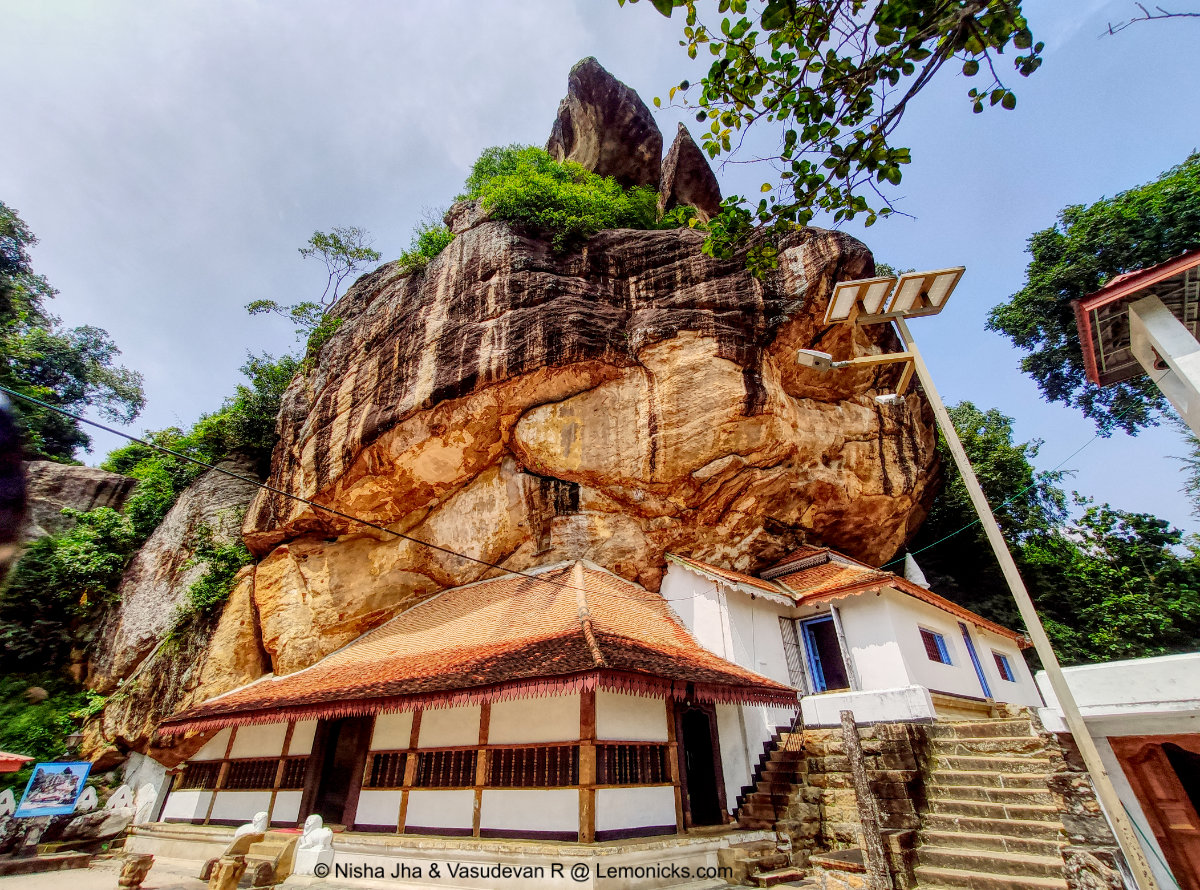
What to do and what to see in Ridee Viharaya
Ridi Viharaya was built as a mark of gratitude to the elder monk (Thera) who showed the cave containing silver, which could be then used to build the Mahathupa. There are two ways to reach Ridee Viharaya. One is to climb 1000 plus steps from Devala Junction to the Ridi Vihara Silver Temple and the second is to drive upto the car park and walk a small distance to the Vihara Complex, which we did to save time. We saw some monks use the steps to reach.
Meeting the Chief Monk
The first thing we did was to meet the chief Monk of the temple at his home-office and paid our respects. We spent a few minutes talking about things in general. The Monk’s quarters are outside the main Viharaya. They also have a huge field where they grow most of their needs. The monk seemed to be quite pleased, meeting us. He encouraged us to have lunch at the guest house once we were done exploring the Silver Temple.
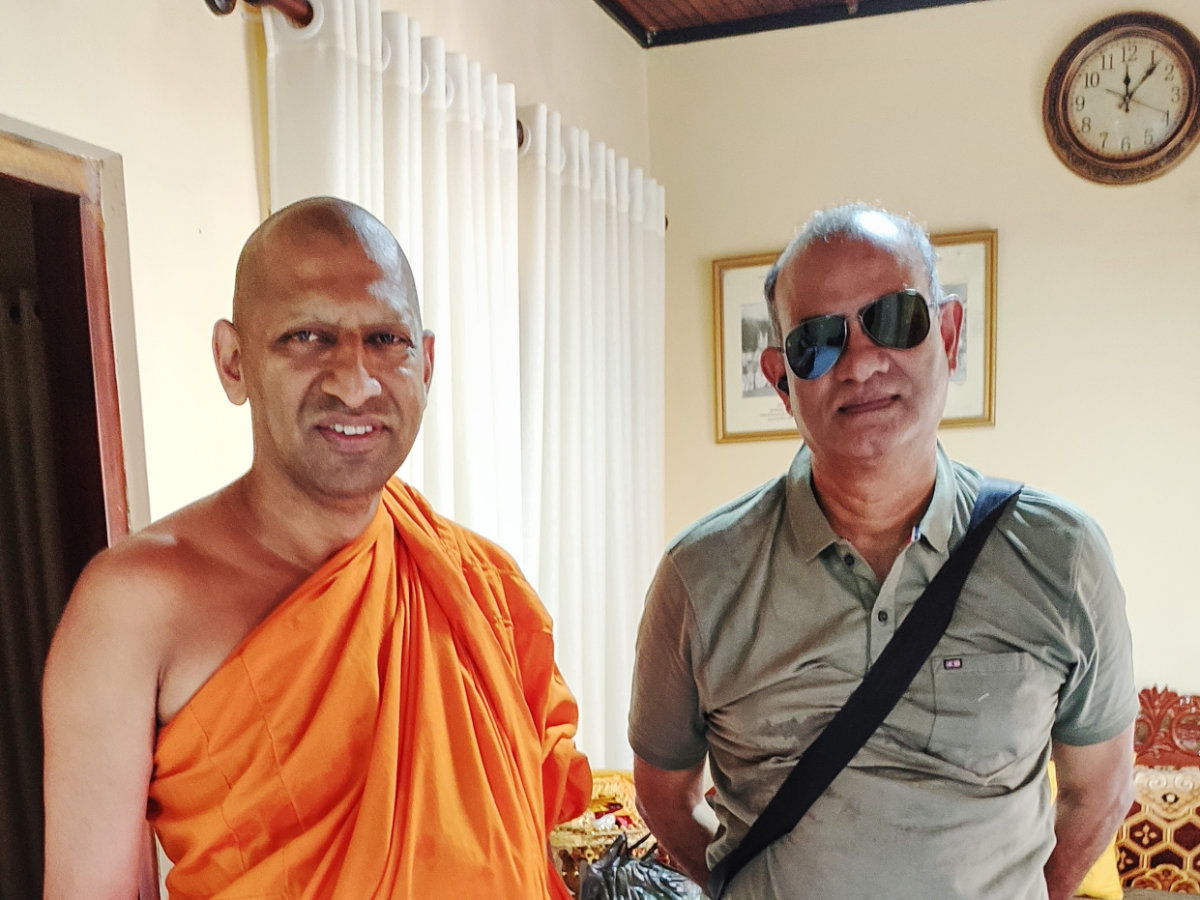
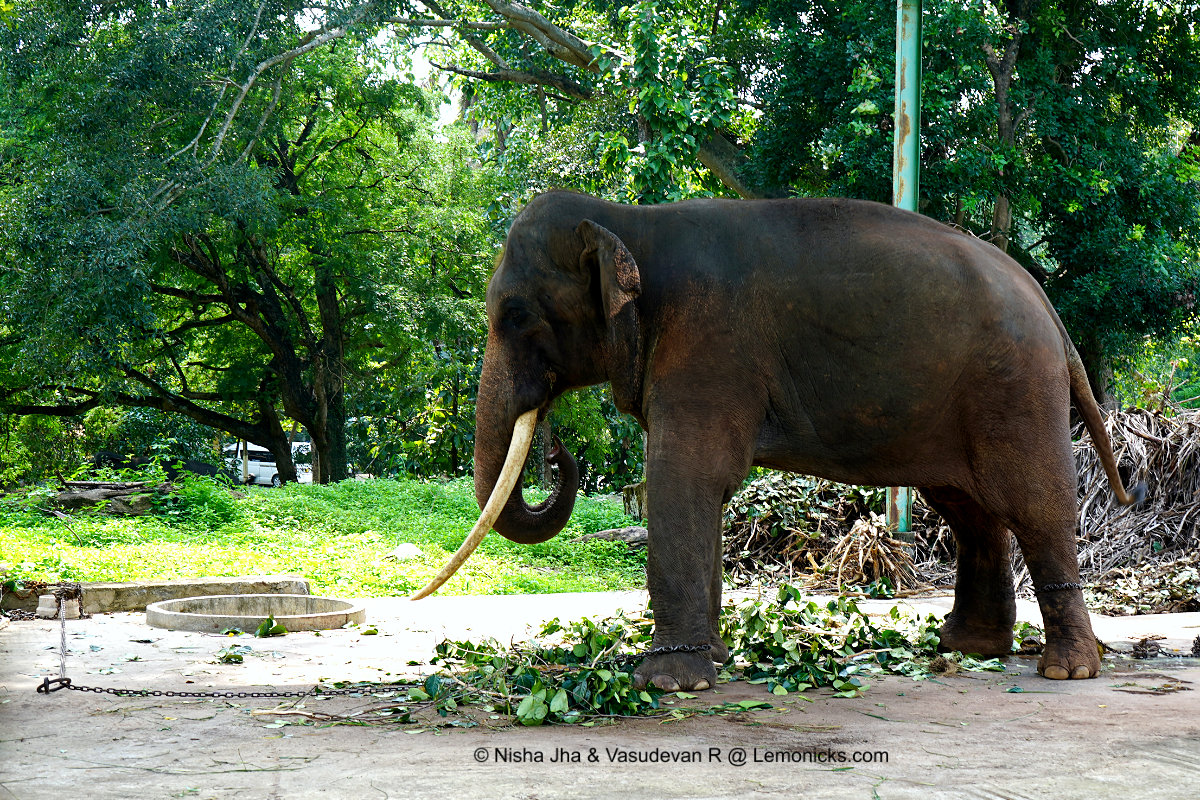
For me, the highlight of the field was an elephant! What a magnificent animal? I was sad to see it chained but then in many parts of the world that seems to be the norm.
Explore Waraka Welandu Viharaya
Waraka Welandu Viharaya was the first structure we saw. To me it looked like an ancient Small Indian temple with 8 well carved pillars but with a sanctum sanctorum which had a sculpture of Buddha. The name literally means the place where breadfruit was consumed. Click here for the complete story. In short, some senior monks made a meal out of a breadfruit offered by a merchant, and one of them, Thera Indragupta, showed the way to the rich silver cave.
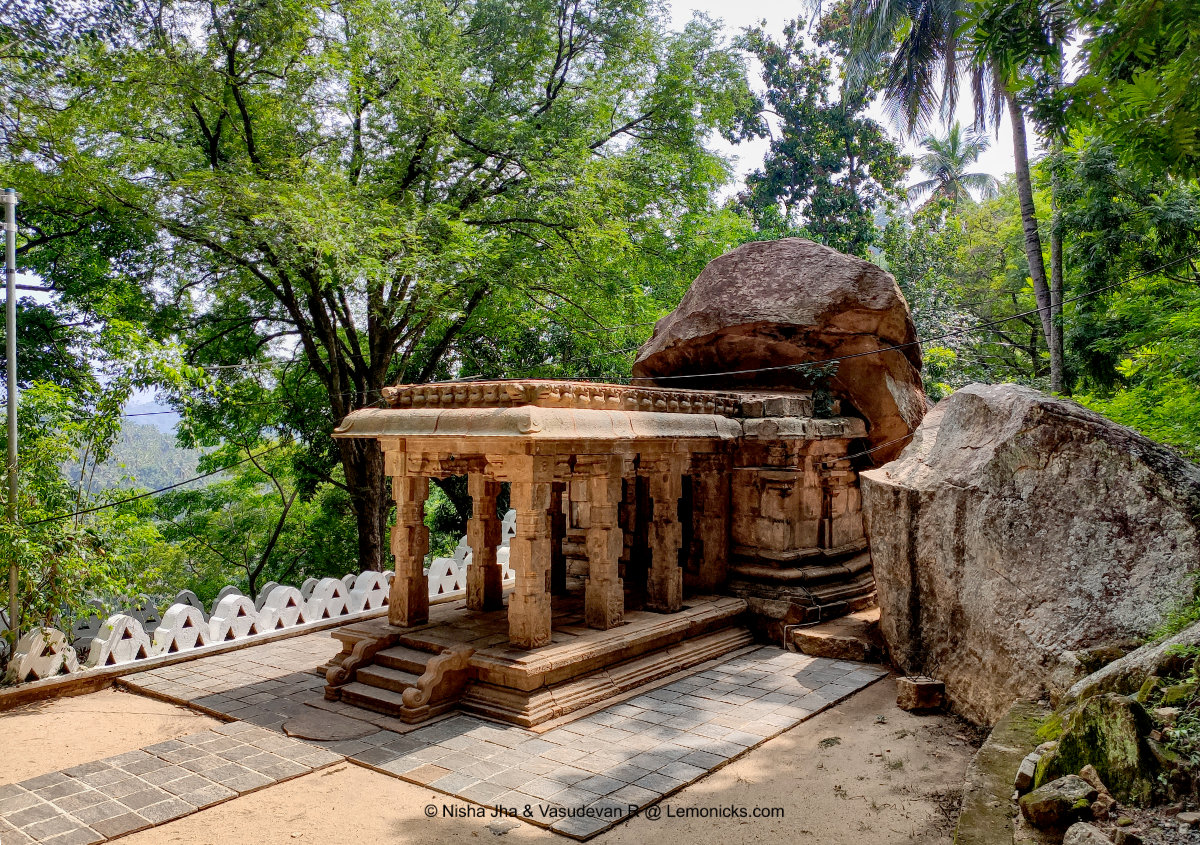
The temple was built probably during the Polonnaruwa period as remembrance of the story. Hindu influence can also be seen in the carvings on the pillars. The sanctum sanctorum is actually a cave which was used by monks in the ancient period, much before Dutugemunu era.
The Buddha and the paintings are likely from the Kandyan period.
Awestruck in the Maha Viharaya, the main temple hall
We walked a bit more and climbed some more steps and reached a courtyard. The main temple Ridi Viharaya was easy to spot. There was a huge rock overhang under which we could discern caves, perhaps used by monks, converted into temples. These caves are now covered with walls and doors. There are beautiful paintings above the main entrance on the rocks. From its faded looks it seems that the elements have not been kind to them. These again may have been from Kandyan or Polonnaruwa period. The rocks have drip ledges, that is, they are cut in such a way that the rainwater does not enter the cave thereby protecting the temple and the people.
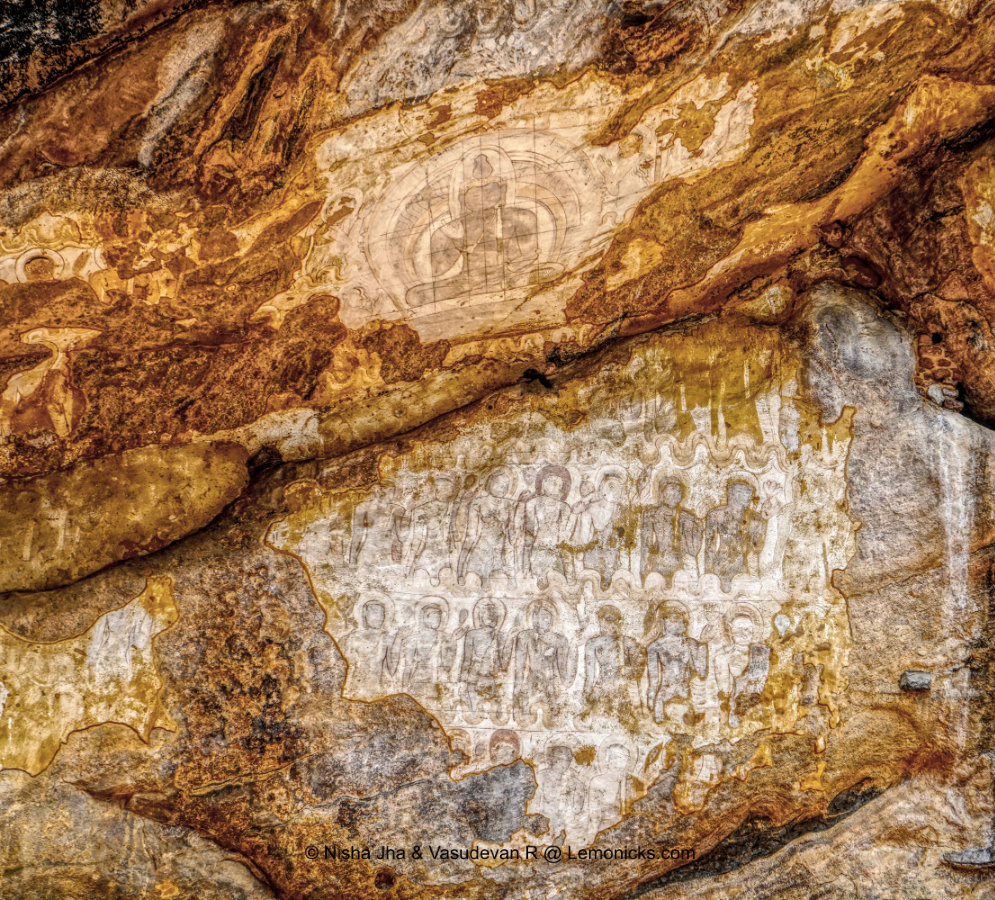
Between the main entrance of the temple and the door to the cave, there is a room with sculptures of dvarpal and lion on either side of the door. The arch has two Makara (the arch is sometimes called Makara Torana) which are mythical animals related to the alligator. For want of a better word many people call it the dragon. Or perhaps they are another mythical beast called the Yali in Tamil.
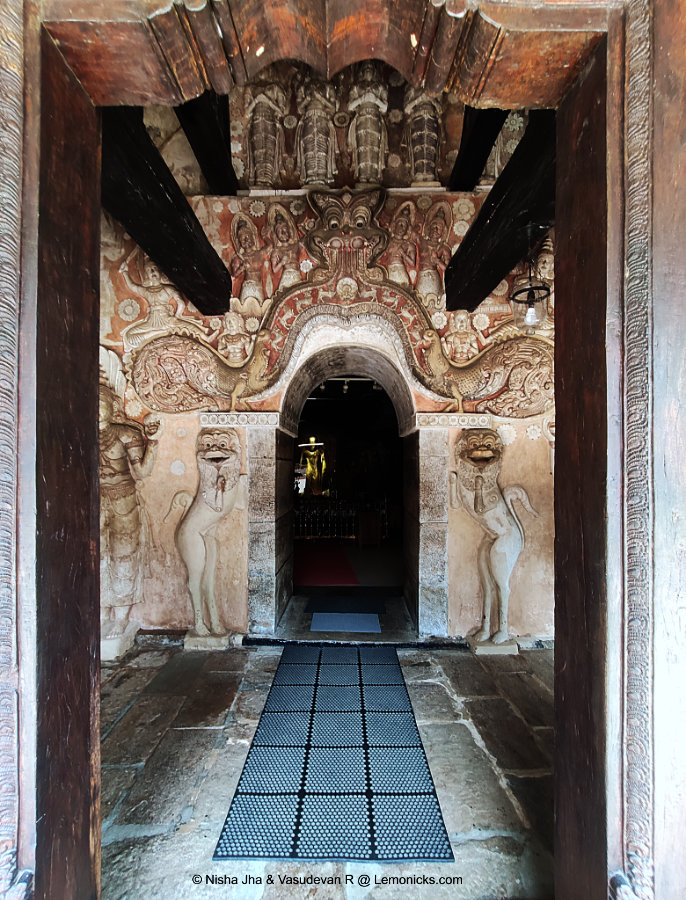
The main hall of the cave of the Viharaya is mostly dark and quite big and adorns the most important sacred object, the golden colored Buddha in standing Varada Mudra posture in a glass cabinet. As per one the ancient chronicle, this golden Buddha was brought from India. The darkness further enhances the glow of the Buddha statue. There are several legends, one of them being that King Dutugemunu installed the Buddha as a gratitude to the Sangha. We were awestruck at the beauty of the cave. There were many statues of standing Buddhas on the right side and one 27-foot sculpture of reclining Buddha, on the left side.
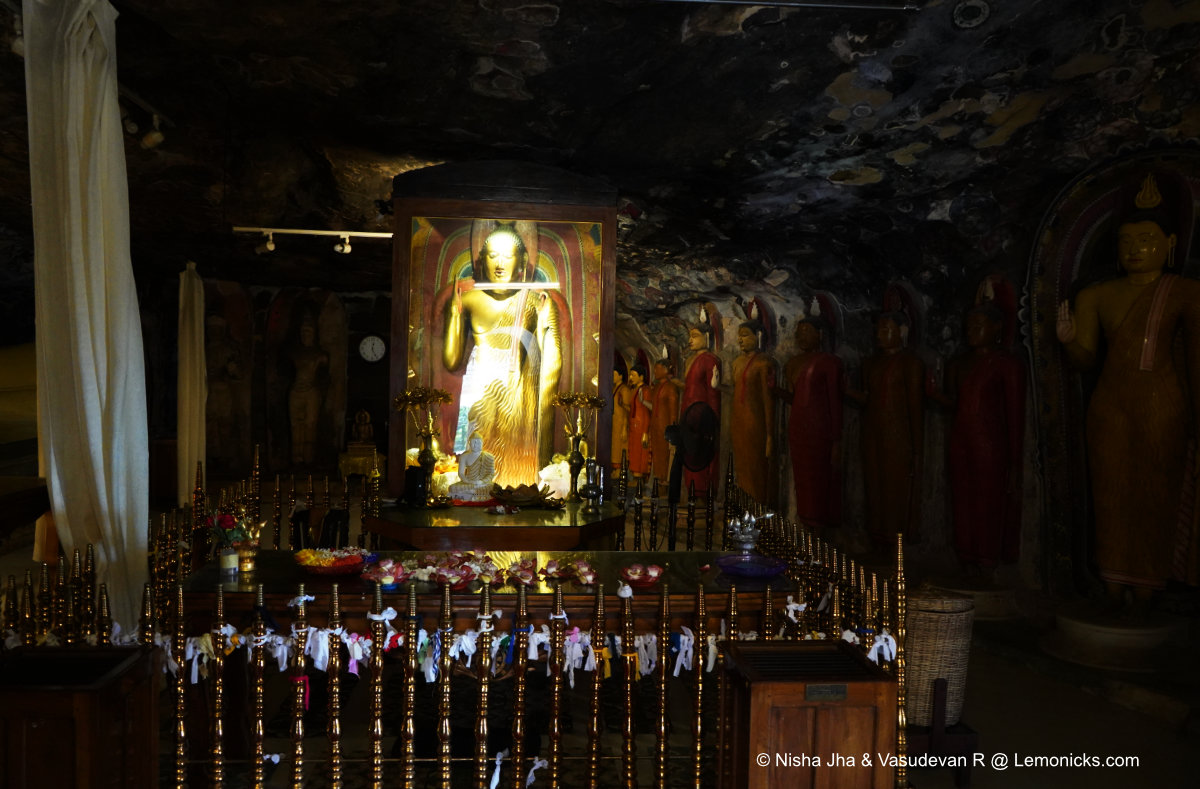
Entire walls and ceiling are covered with paintings depicting life of Buddha, Jataka tales etc.
Uda Vihara or the Upper Vihara
After coming out we turn left and climb a few more steps to reach Uda Viharaya or the Upper temple. The entrance steps to the temple have elephant shaped wing stones and one of the most beautiful moonstones. It is called Sandakada Pahana. Unfortunately, it was locked. So, we could not go in. We were informed that inside the room, there were more sacred objects, paintings, some of them quite exquisite, and statues from the Kandyan period.
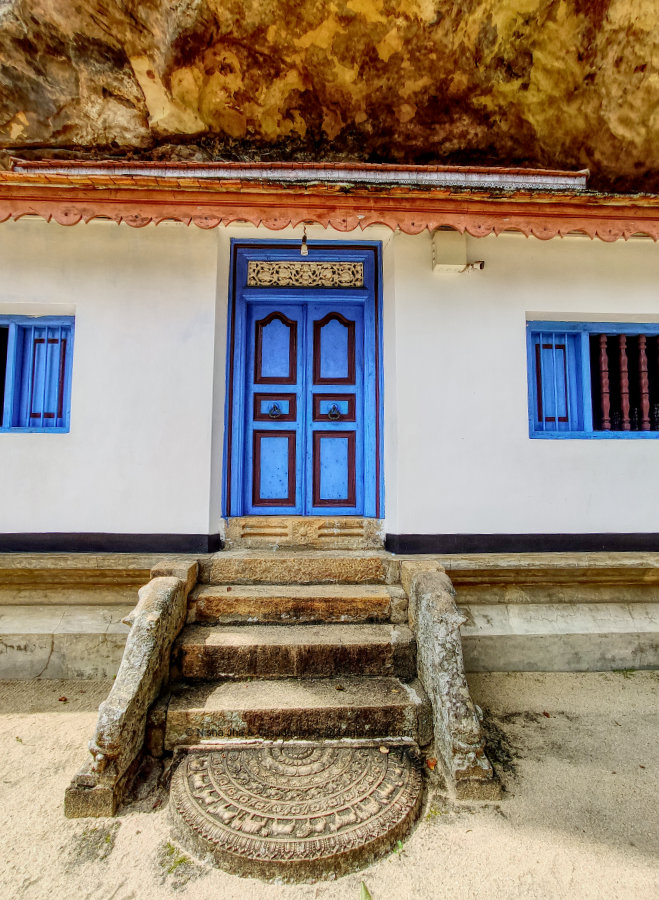
Some say, even the painting of Ravana is there. Wish the doors were open!
Stupa
The last structure is a Stupa. The highlight of this place is that there are inscriptions above the stupa on the rock face. It says, “The cave of the Chief Abhaya”. Perhaps referring to King Dutugemunu Abhaya!
Serasumgala Cetiya and Pahangala
After finishing our tour of the temple, we decided to hike a bit as we were told the Temple trust was planning to build caves for people who want to meditate!
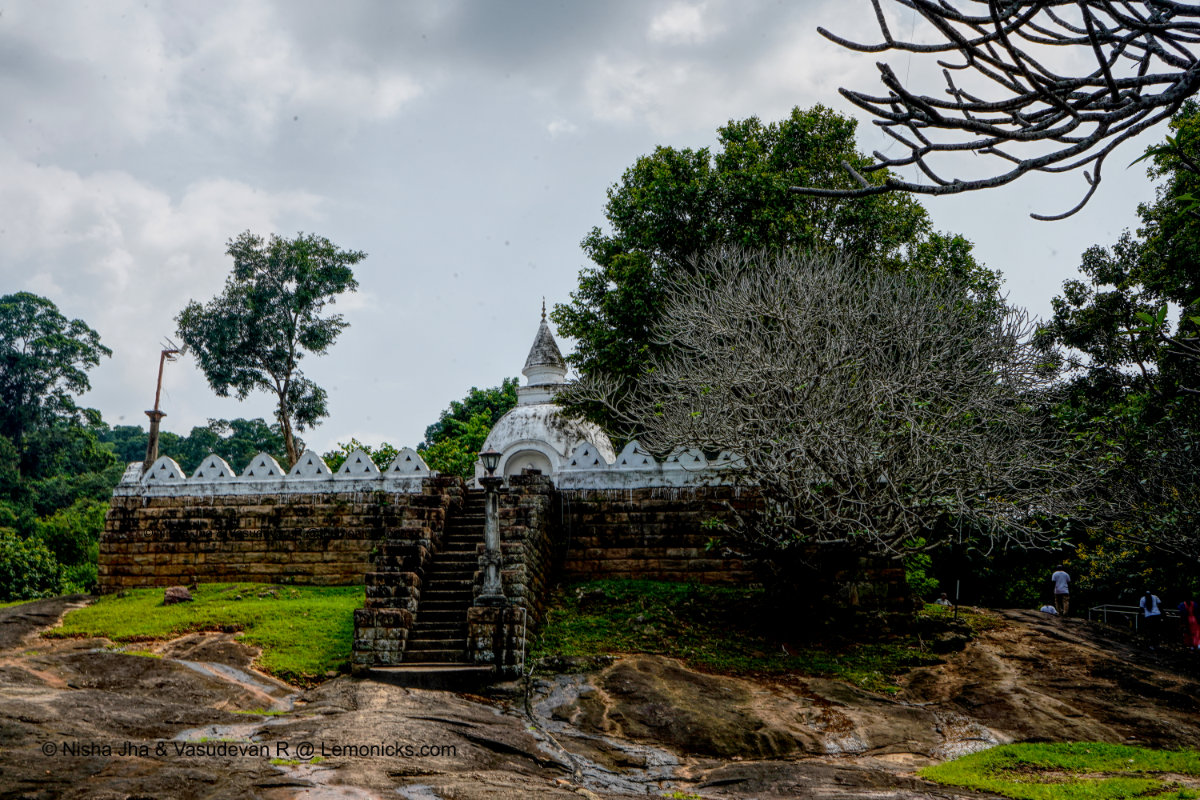
The first few minutes of climbing the steps were quite easy and we saw many more rock inscriptions in Pali or Prakrit language written using Brahmi script which was in vogue in those days. One of them dated 22-31 CE (AD) talks about how King Gamini Abhaya donated 2 villages (!) by pouring water from his golden jug (Kamandalam). It does not say to whom they were donated but I would assume the Sangha.
On the top of the hill is a stupa perhaps dedicated to the place where King Duttagamini changed before entering the Viharaya.
The steps give way to a trail that is a bit difficult for those who are not physically fit. This area is a biodiversity region which also provides awesome views. When we went it was quite misty to see anything clearly.
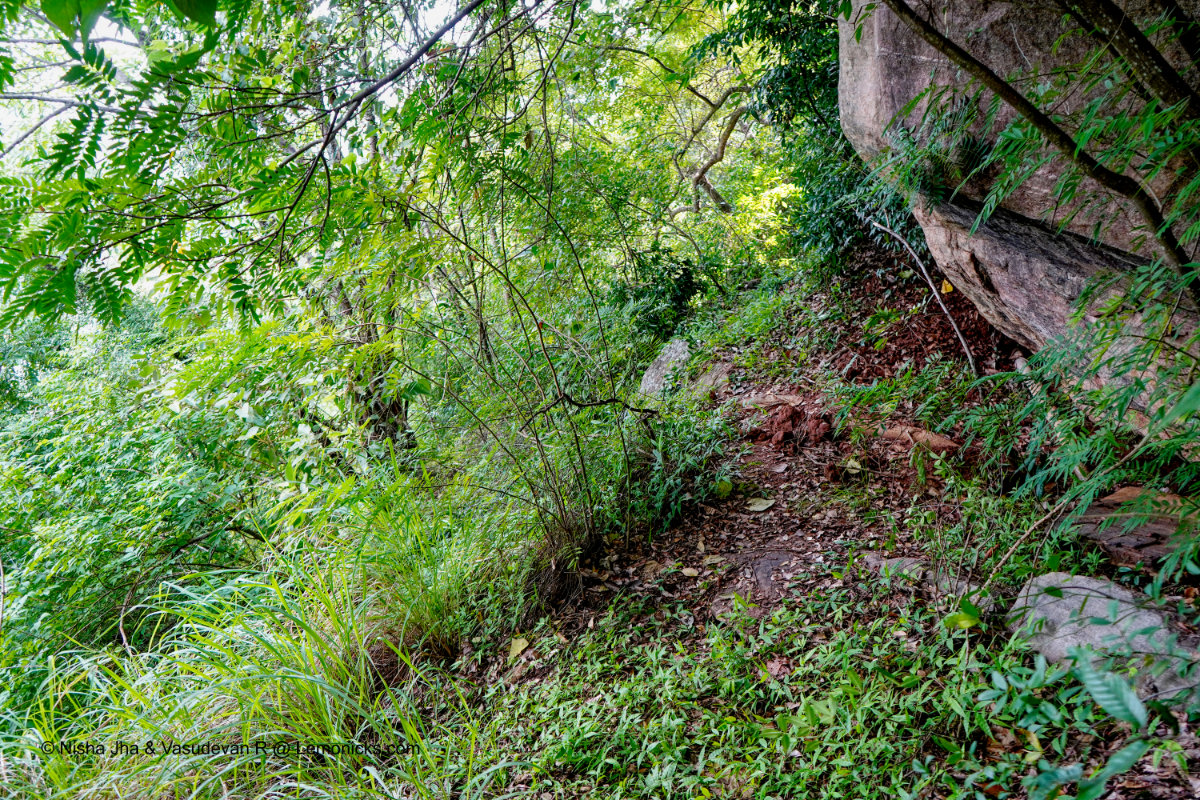
After 30 minutes we reached the place where some archaeologists were digging and where the trust is planning to prepare some caves for meditation by anyone who wants to.
The Legend, the Story and the History of Ridi Viharaya
When we talk about the happenings over 2000 years ago, one must rely heavily on the beliefs of the people and multiple interpretations of the oral traditions and written books, such as Deepavamsa, Mahavamsa, Culavamsa etc. Alternately one must be lucky, which I was, to have a guide like Marcus Fernando!
Dutugemunu Abhaya
Dutugemunu (also spelt as Duttagamini, DutuGamunu, Dutthagamani etc) was perhaps one of the most powerful Kings and a valiant warrior of Sri Lanka during the middle of 2nd century BCE and credited with uniting the whole Island into one Kingdom. He did that by defeating and killing the then ruler of Anuradhapura Chola King Ellalan (Elara in Sinhalese) aka Manu Nidhi Chozhan (in Tamil) during one-to-one fight seated on their elephants.
The word Dutta is shortened form of the Sanskrit word Dushtha which means an evil, wicked or an unpleasant person. That is another story which I will probably write about later. His reign is remembered for bringing peace, prosperity and unity to the country. He will always remain an integral part of Sri Lankan history. The story of Ellalan is also quite interesting which I hope to write about sometime.

Dutugamunu is credited with building many memorials, palaces, places of worship, both Buddhist and Hindu temples. “Fearless” (Abhaya) was his second name.
The Mirisawetiya Dagoba was the first monument built by King Dutugemenu after he consecrated it (161-158 BC) to commemorate his victory over the Tamil ruler Elara (Ellalan).
Ruwanwelisaya (Swarnamali Mahaseya)
His favorite project was building the Ruwanwelisaya, a Dagoba of mammoth proportions, protecting multiple Buddha relics deep inside its bosom. It is now the number-one pilgrimage place for the SriLankan devotees.
His treasury was almost empty due to long wars. He had to somehow raise resources in terms of money and means for building this beautiful Dagoba.
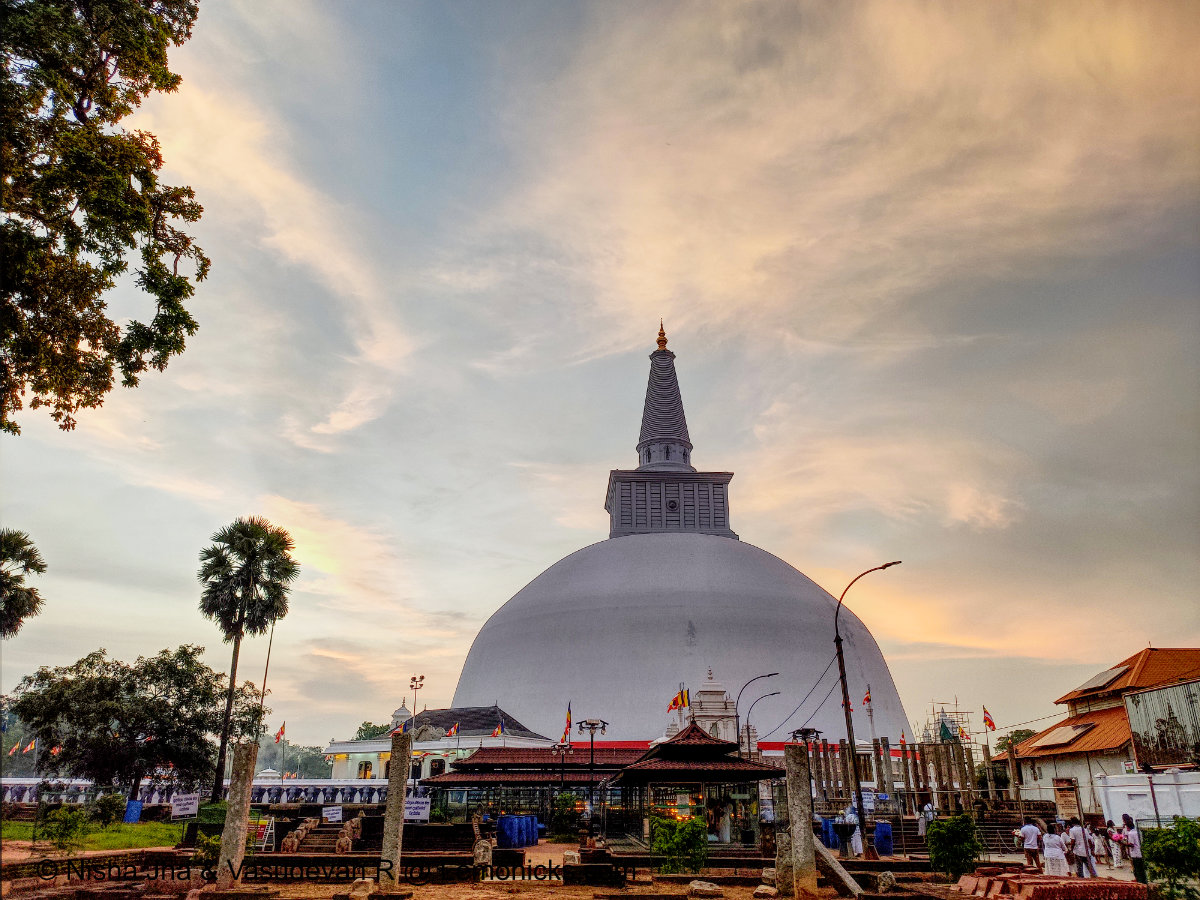
The following account is based on Mahavamsa and Marcus, our guide.
Once when he was resting, one of the minor gods (devata) depicted as an image on the ceiling of the Kings Chamber noticed and understood the Kings dilemma. The dilemma was whether to tax the newly acquired subjects or not. The Gods gathered and directed Vssakamma (Vishwakarma, the god of architecture and construction) to prepare bricks. Next day a hunter found an iguana (which was actually the god of that forest) and chased it till it vanished at the very place where the bricks had been manufactured earlier. He duly informed the king about the bricks which could be used to build the Mahathupa.
The dwellers of a village about 3 Yojanas away (1 yojana about 12 km) found a lot of gold nuggets which they deposited with the king.
Copper appeared in a village about 7 yojanas away in the east. Precious stones appeared elsewhere.
Ambatthakola Lena (Cave)
A ginger merchant was travelling to Malaydesa in the South of Anuradhapura. He halted at a place near the mountains to gather some wood. There he saw a huge breadfruit, which he decided would give as alms to the Buddha Bhikkus or Theras. Soon enough, four of them came around. He greeted them reverentially and he offered them the fruit. After they left 4 more came to whom he offered them the kernels of the fruit.
(Note: many articles on the internet says it is jackfruit, however Mahavamsa says it is Breadfruit).
Three of the Theras left but one of them went near a cave and had his meal there. The merchant followed him upon which the monk opened a way to the cave of silver and asked the merchant to go in and mine the silver. The merchant took a few lumps to the king immediately. This place was about 8 yojanas from Anuradhapura.
Ambatthakola cave is nothing but this location of the Ridi Vihara Cave temple which is about 100 KM from Anuradhapura (just over 8 yojanas). After the discovery of silver here, it was named Rajatha Lena (Silver Cave).
More riches were found in all directions. On a single day, all resources needed to build Mahathupa were collected. However, King Dutugemunu was unfortunate not to be able to witness the completion of the Vihara because of his death.
Useful Information on Ridi Viharaya Silver Temple
Tips
- Dambulla, or Hebarana is a good place to stay for a few days and cover all the major heritage sights like, Ridee Viharaya, Dambulla Rock Cave Temple, Anuradhapura, Polonnaruwa, Mihintale, Minneriya Elephant reserve, Sigiriya etc.
- Footwear and hats are not allowed inside the complex. It is better to explore during the morning hours before the sun goes high, granite floors and sand gets too hot.
- For hiking to Serasumgala, footwear are allowed, as it is outside the Silver temple’s premises.
- It may take 1 to 2 hours to explore the place not including the hiking part. However, if photography is your thing, it may take more time as there are many paintings and sculpture.
- It would be a good to read about the history of Ridi Vihara on the internet (like this article 🙂 ) or engage a guide.
Where to stay near Ridi Viharaya Silver Temple?
For those who want to spend a night or two in its peaceful environs, there are rooms and food available free of charge (Donations are welcome). I personally encourage the guests to donate as it really costs a lot to maintain this beautiful property.
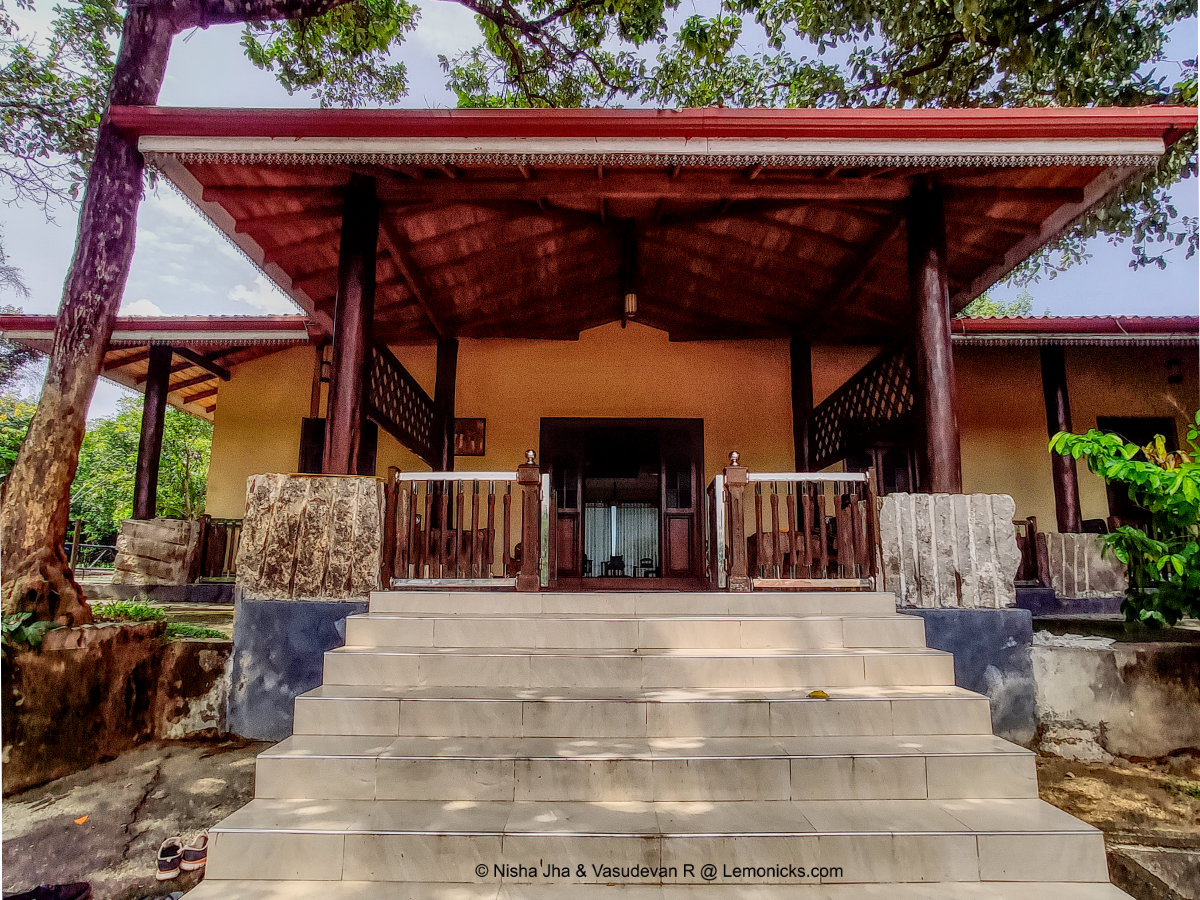
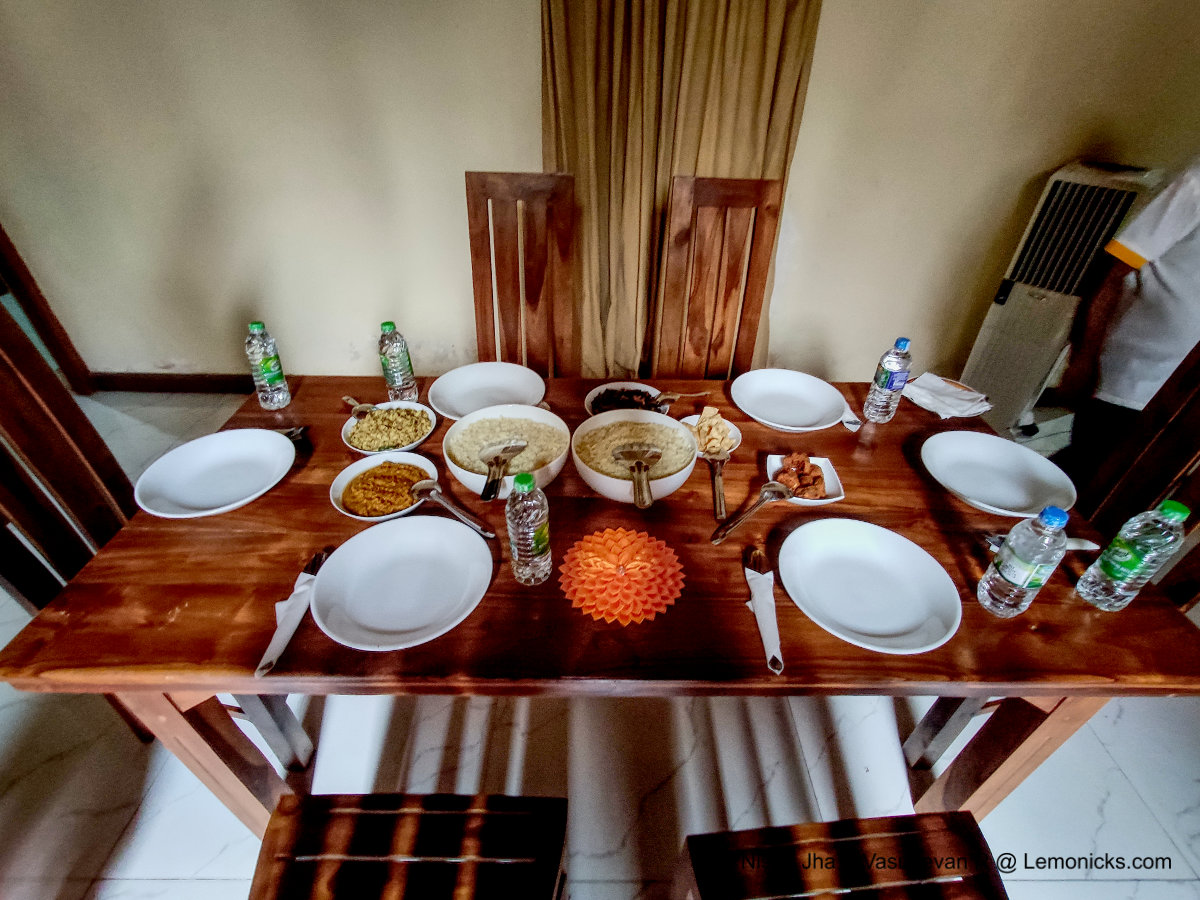
This guest house is run by the Vihara Trust and is just a few 100 metres from Ridi Viharaya Silver Temple. There are 4 reasonably well appointed and AC rooms. I was bowled over by the beautiful views. It was also interesting to note that they grew many vegetables in their huge “Kitchen” garden.
Contact telephone: +94 77 50 50 670 or visit https://rideeviharaya.lk
Please Click here for other accommodation options in Dambulla and Habarena
We Stayed at Jetwings Lake. Click here to book.
FAQ
How to reach the Ridee silver temple?
Ridee Vihara is about 120 KM from Colombo.
The cheapest way is to take a train from Colombo Fort Railway station to Kurunegala and then take a tuk tuk or taxi to Ridee Vihara.
If your are a tourist on a tight schedule then the best way is to hire a cab from Colombo itself and then add a few more sights.
Is Photography Allowed inside the temple?
Yes, photography is allowed inside the temple. If photographing people make sure image of Buddha is not behind the subject.
Are there too many steps to climb to get to the Ridi Vihara main temple?
There are not many steps and even they are quite easy. From the parking lot it is just about 100 Metres. For the more adventurous, a flight of 1300 steps rise right from the bottom of the hill which used to be the only way during the ancient times.
Which school of Buddhism are being followed by the monks of Ridi Viharaya?
Ridi Viharaya (the silver cave temple) , like most other Buddhist temples in Sri Lanka, follow the Theravada school of Buddhism. It is believed that Theravada is the original Buddhism.
Photograph Copyright
All photographs used in this article belong to the owners of this website www.lemonicks.com unless otherwise specified. Copying or using them without explicit permission is prohibited and will amount to copyright infringement.
If you want to travel places with us, we invite you to join our feed or Facebook travel page.
P.S.- This article, Complete Guide to Ridi Viharaya Silver Temple, belongs to Le Monde, the Poetic Travels, one of the top Indian Travel Blogs, published by the traveling couple bloggers, Nisha & Vasudevan. Reproduction without explicit permission is prohibited. If you are viewing this on another website other than the RSS feed reader or www.lemonicks.com itself, then that website is guilty of stealing our content. Kindly do us a favour by letting us know via Contact Us. Thank you.
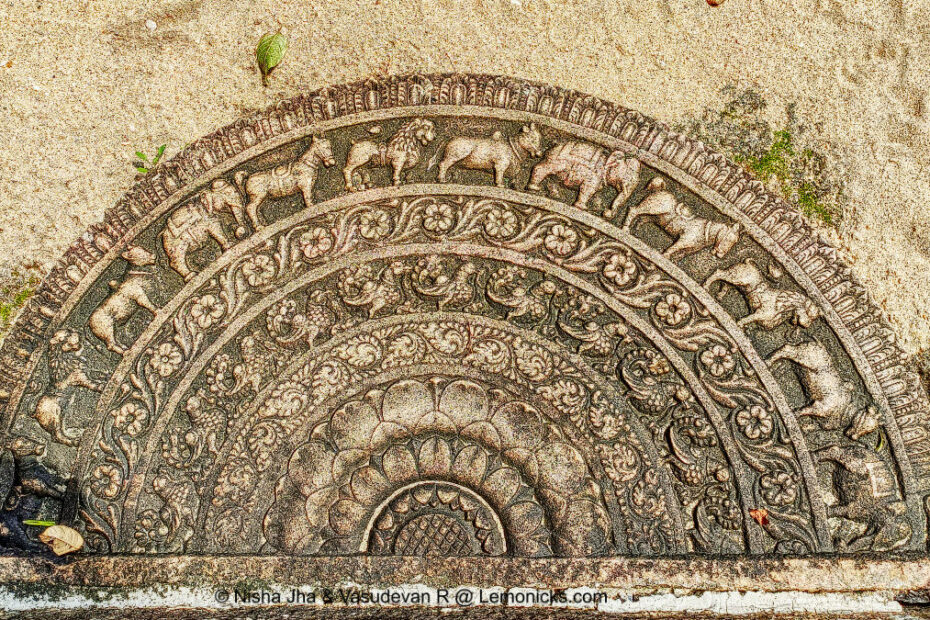
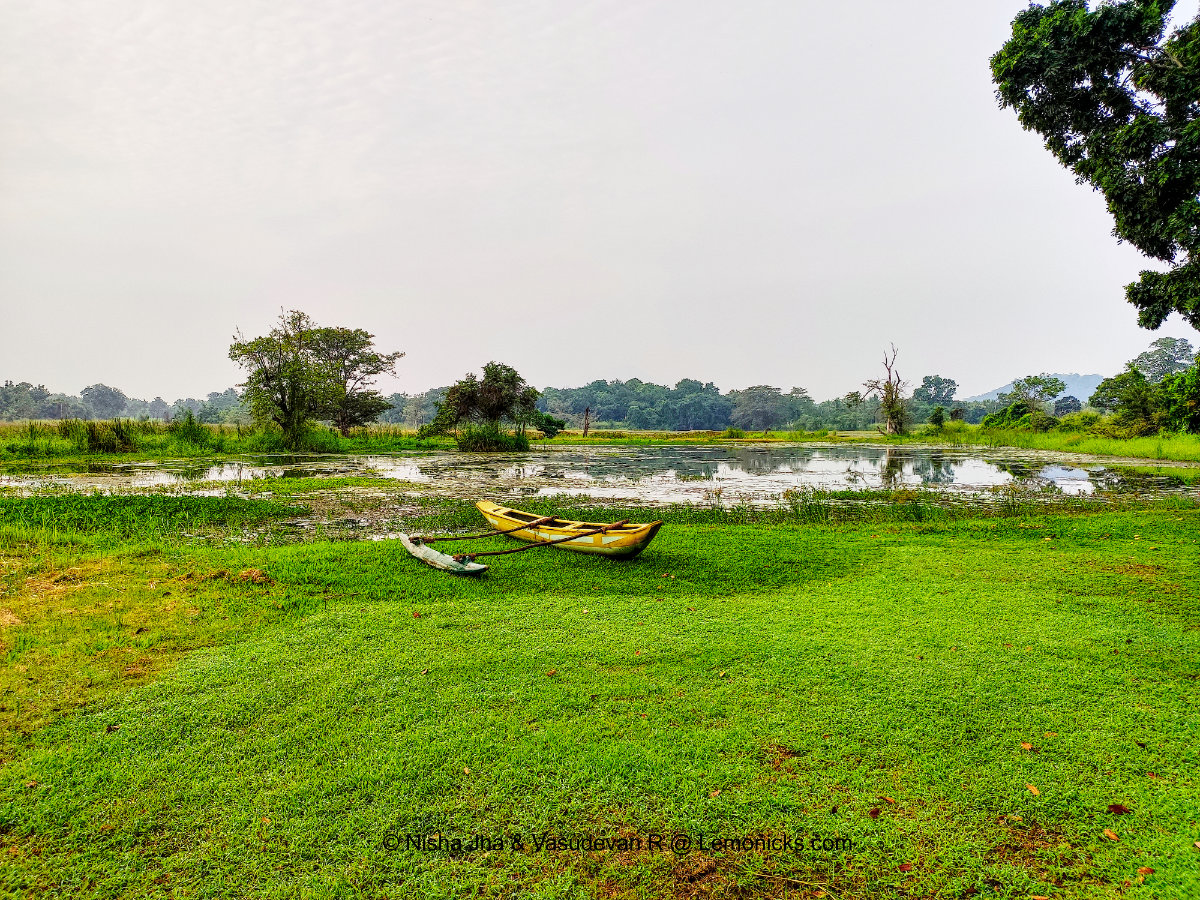

I absolutely love the photos of this blog post. Sri Lanka has always been on my travel wish list. I will bookmark this blog post and refer back to it when I am fortunate to visit Sri Lanka. I cannot wait! Thank you for sharing.
I’m thrilled to hear that you enjoyed the photos in my blog post on Ridi Vihara at Dambulla Sri Lanka! It’s always exciting to have a travel wish list, and I hope that Sri Lanka becomes a reality for you soon. Don’t hesitate to reach out if you need any recommendations or advice for your trip – happy travels!
WOW! This is such a thorough and well put together summary of Ridi Viharaya. It looks like a fascinating place to visit and I’ll be lucky if I get to go one day. Thank you for sharing your expertise
Thank you for the compliment! I’m glad you found my complete guide of Ridi Viharaya helpful and fascinating. Who knows, maybe one day you’ll be able to visit and see the beauty of it in person. In the meantime, keep exploring and discovering new places!
I have yet to travel to Sri Lanka – but is is on my list of places I would love to go. After reading through this article on the temple and other sites in the area I’ll have to try to move it up on my travel list – beautiful place and temple!
Good to know that Sri Lanka just made it to the top of your travel list! I guess you can say this article temple-ted (tempted) you into wanting to visit. I’m sure you’ll find your way there and have an amazing time!
Wow, I love visiting temples. We have a lot here in Japan but I would love to explore other country’s too. Someday, I will visit Sri Lanka for this!
I am surely going to bookmark this post! This is a really great guide thanks for sharing this with us
I really enjoyed reading your article about Ridi Viharaya Silver Temple in Sri Lanka. The way you described the temple’s history, architecture, and significance made me feel like I was there. The photos you included were stunning and really added to the overall experience. Keep up the fantastic work!
Wow! Visiting these places must be an awesome experience! Thank you for sharing such a wonderful review!
I have not traveled to Sri Lanka but would love to do so someday. Ridi Viharaya is an awesome place to visit. The temple is a spectacular sight!
Aaaahhhhh…thank you for sharing about the Ridi Vihiraya Silver Temple. I am glad to know that taking photos is allowed inside the temple. It’s too beautiful not to have any photos of it taken.
I would love to travel to Sri Lanka one day. The beauty and the culture are so interesting and enriching.
It must have been very interesting to go see Ridi Viharaya. If we get to go I’ll take your advice and make sure that we go during the morning before the floor and sand is too hot x
What a neat place to explore. The temple is so unique and interesting. I have never been to Sri Lanka, and it is cool that you were able to check out these destinations.
What a gorgeous place to visit! I also appreciate how meaningful it is for those who go there.
Absolutely mesmerizing! This blog beautifully captures the essence of temples in Sri Lanka, each a testament to the country’s rich history and spiritual heritage. From the intricate architecture to the serene ambiance, it’s evident why these temples hold such significance. Truly inspired to plan my pilgrimage journey!
Thank you so much for your kind words! It’s truly heartwarming to hear that the blog resonated with you and sparked inspiration for your pilgrimage journey. Sri Lanka’s temples are indeed treasures, each telling stories of rich history and spiritual depth.